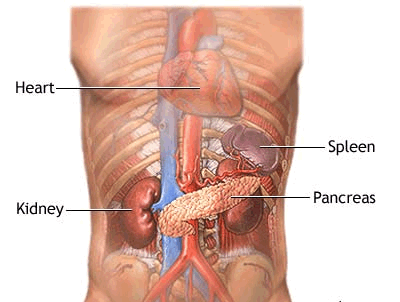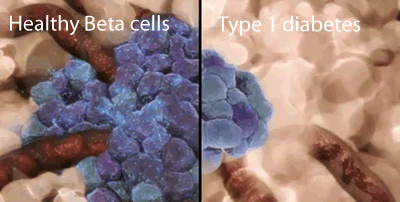The pancreas is an organ, located just behind the stomach, that is part of the digestive system responsible for producing hormones to regulate blood glucose levels. Insulin is one hormone produced by special cells in the pancreas called beta cells and is responsible for lowering blood sugar levels.
As glucose rich blood flows through the pancreas, glucose moves from the blood into the beta cells. Beta cells respond by excreting insulin into the blood.
Insulin flows to three main destinations , liver, muscle and fat tissue. Insulin helps these tissues to store glucose as an energy source.
Muscle and liver cells have proteins, called receptors, attached to the surface of the cell that lock and bind insulin. Once the insulin binds with the receptor protein channels open at the surface to allow glucose into the cell.

View the video on the right. It provides a quick overview of how insulin works.
Foods eaten are broken down into smaller simpler molecules. Carbohydrates, such as starch, are broken down into in the digestive tract before being absorbed into the blood.
What is the main source of energy for brain and muscles?
As long as sugar is circulating in the blood it can be used by the cells . Explain.
In type 1 diabetes the person's own immune system attacks and destroys the beta cells in the pancreas, severely reducing the size of the islets of beta cells, as shown on the right. This severely reduces their capacity to produce enough insulin to meet the body's demands. Type 1 diabetes is referred to as an autoimmune disease because the body's immune system attacks its own cells in error.

This description was taken from an article by the Diabetes Research Centre Melbourne
.
Type 2 diabetes is much more common than type 1 diabetes and affects about 10% of Australian adults, but the frequency is increasing dramatically throughout the country.
Whilst people with type 1 diabetes have insufficient insulin production, those with type 2 diabetes are still able to produce insulin, but their body is unable to use it to help enable glucose to enter cells. This ‘insulin resistance’ develops very slowly, so at the time of diagnosis, individuals with type 2 diabetes may have had the disease for several years and often will not feel unwell. However, over a period of many years, type 2 diabetes can cause significant health problems.
View the video on the right. It gives a brief outline of type 2 diabetes. Answer the questions below.
Diabetes type 2 is more common in what group of people?
How does type 2 diabetes differ from type 1?
What happens when excess blood glucose persists?
High blood glucose level is known as hyperglycemia. What organs are in danger of damage due to hyperglycemia?
Look at the video on the right and answer the questions below.
Explain why diabetics easily dehydrate, feel hungry and tired?
What is the primary cause of death amongst type 2 diabetics?
Why is the healing process severely hampered in diabetics?
Name two other complications suffered by diabetics.
Diabetics are in greater danger of developing arterial sclerotic plaques. What is a sclerotic plaque?
Eating sugar causes diabetes Solution
Diabetics have to plan their diet. Though the general principal is easy: Following a "diabetes diet" means choosing food that can work with your activities and any medications to help keep your glucose levels as near to normal as possible.
Hide solution
So how exactly does diabetes happen? The reasons are certainly not totally understood. What exactly is known is that simply overeating sugar is not likely to cause diabetes. Instead, diabetes begins when something disrupts your own body's capacity to turn foods into energy. To comprehend what goes on when you've got diabetes, keep these things in your mind: Your body breaks carbohydrates, such as starch in our foods into glucose, a sort of sugar necessary to power your cells. A hormone called insulin is created inside the pancreas. Insulin helps cells in your body use glucose for fuel. Listed below are the commonest kinds of diabetes and what researchers know about:
* Type 1 diabetes takes place when the pancreas cannot make insulin.
* Diabetes type 2 happens when the insulin present can not do its job properly, and may be coupled with severe insulin deficiency.
* Gestational diabetes occurs during pregnancy in certain women.
Hide solution
Diabetics must adhere to strict diets designed to keep blood sugar down as low as possible. Solution
In reality, carbohydrates are great for diabetes. They make up the foundation of a proper diabetes diet. Carbohydrates possess the greatest impact on blood sugar, which is the reason you are required to observe the amount of carbohydrates you consume when following a diabetes diet.
Hide solution
Carbohydrates are dangerous to diabetics. Solution
The major problem is many foods abundant in protein, including meat, can be stuffed with saturated fats. Overeating those fats increases your risk of heart problems. In the diabetes diet, protein should account for about 15% to 20% of the total calories you consume every day.
Hide Solution
A diet high in protein and low in carbohydrate is preferable for diabetics. Solution
Diabetics can eat as much as they like and simply adjust the amount of insulin injected to compensate for the volume of food ingested. Solution
If you utilize insulin for your diabetes, you might discover ways to adjust the total amount and type you take to complement the quantity of what you eat. But this does not mean you can eat just as much as you would like, then just use more drugs to stabilize your blood glucose levels level.
Hide solution
Diabetics can still eat desserts Solution
Sugar substitutes tend to be sweeter compared to the equivalent volume of sugar, therefore it takes a reduced amount of them to have the same sweetness present in sugar. This may cause eating fewer calories than when you use sugar.
Hide solution
Far from the truth! You'll be able to develop many approaches for including desserts in the diabetes diet. For example:
* Use low calorie sweeteners in desserts.
Hide solution
Sugar substitutes are dangerous for those who have diabetes. Solution
Just because a meal is called a "diet" food does not necessarily mean it's a better option for those who have diabetes. The truth is, "diet" foods may be expensive and no better than foods found in the "regular" areas of the supermarket, or foods you prepare yourself.
Hide solution
Diet foods are the most useful selections for diabetes. Solution
This worksheet was produced with information provided by Dorothy Kato [dorothy@diabeticmenus.org]